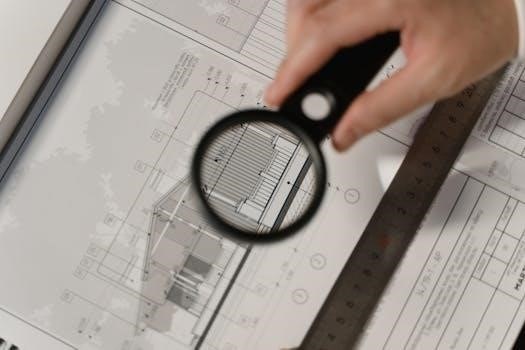Cadence design tools are a suite of software packages used for integrated circuit design. These tools support the development of analog‚ digital‚ and mixed-signal circuits. The suite includes schematic composers‚ circuit simulators‚ and layout editors‚ essential for a comprehensive IC design process.
Overview of Cadence Design Suite
The Cadence Design Suite is a comprehensive collection of software tools essential for integrated circuit (IC) design‚ spanning from initial concept to final implementation. It encompasses a wide range of functionalities‚ including schematic capture‚ circuit simulation‚ layout editing‚ and verification‚ catering to both analog and digital design workflows. The suite is widely used in the industry and academia‚ proving its reliability and efficiency in the intricate process of IC design. With the Cadence Design Suite‚ engineers can create‚ simulate‚ and verify complex integrated circuits with relative ease‚ and it provides a structured environment for managing different design stages and collaborating on large projects. Moreover‚ the suite helps engineers design high-performance‚ reliable‚ and efficient ICs for diverse applications‚ and its powerful features enable users to tackle even the most challenging design problems. The environment is also optimized for custom‚ analog‚ and RF designs.
Cadence Tool Usage in IC Design
Cadence tools play a crucial role in the IC design process‚ offering a wide array of functionalities that cater to various design stages. From schematic capture using the Composer Schematic Editor to circuit simulation with tools like Spectre‚ Cadence facilitates the creation and analysis of both analog and digital circuits. In the analog domain‚ Cadence tools are used extensively for circuit design‚ simulation‚ and layout‚ providing a comprehensive platform for creating complex analog ICs. For digital IC design‚ Cadence enables designers to implement their logic designs into physical layouts‚ and also provides tools for floorplanning‚ placement‚ and routing of digital circuits. The tools also play a role in the verification stage and can help to analyze designs‚ identify issues‚ and ensure that circuits work as intended‚ providing a robust platform for the entire design process from the initial concept to the final layout.
Setting Up the Cadence Environment
To begin using Cadence tools‚ it’s essential to set up the environment correctly. This includes creating necessary directories and ensuring the Cadence software is accessible through the command line. Proper setup is critical for smooth workflow.

Initial Setup and Directory Creation
The initial step in utilizing Cadence IC design tools involves setting up the environment‚ which begins with creating a dedicated directory for your project. This directory will house all design files‚ libraries‚ and simulation results. It’s important to choose a location that is easily accessible and organized. For example‚ a common practice is to create a directory within your home directory named after your project or course‚ such as ‘ee434’. This ensures that all project-related files are kept together. After creating the directory‚ you will need to navigate into it using the terminal. This will be your working directory for all subsequent Cadence operations. The correct directory structure helps to prevent file management issues and enables a smoother workflow when using the Cadence tools. This organized approach ensures that all project files are easily retrievable‚ and it will be essential as the project grows in complexity.
Starting the Cadence Custom IC Tool
Once the project directory is set up‚ the next step is to launch the Cadence Custom IC tool. This is typically done by executing the command ‘icfb’ in the terminal. Ensure that you are currently within your project directory before executing this command. This command initiates the Cadence Design Framework II‚ which is a core component of the Cadence IC design environment. Upon successful execution‚ the main Cadence window will appear‚ indicating that the tool is ready to use. Before starting a new design‚ it is important to verify that the correct libraries and technology files are loaded. This will ensure that the circuit elements you need are available and that the design process is smooth. The Cadence environment will then be ready for schematic capture and simulation and layout activities. This is the starting point for all design activities.

Cadence Tools in the Design Flow
Cadence tools play a vital role in both analog and digital IC design flows. They facilitate the entire process from initial concept to final implementation‚ enabling engineers to create complex integrated circuits efficiently.

Analog IC Design Flow with Cadence
The analog IC design flow using Cadence tools typically begins with schematic capture‚ where the circuit is designed using the Cadence Composer Schematic Editor. This can also be done through a text netlist input. Following schematic entry‚ circuit simulation is performed using tools like Spectre‚ allowing designers to analyze and verify the circuit’s behavior. The simulation results inform design adjustments and optimizations. Once the design meets performance requirements‚ the layout process begins where physical implementation is done‚ often using Virtuoso Layout Suite. This involves creating and editing cell-level designs‚ and placing instances to build a hierarchy. The design flow also encompasses post-layout verification‚ ensuring that the physical layout meets design specifications. This iterative process‚ supported by Cadence’s robust toolset‚ ensures the creation of high-performance‚ efficient‚ and reliable analog integrated circuits. The Cadence environment allows for the practical aspects of design to be considered throughout the flow.

Digital IC Design Flow with Cadence
The digital IC design flow with Cadence tools encompasses both front-end and back-end processes. The front-end design involves the creation of digital logic using hardware description languages and synthesis tools. Cadence tools aid in this phase by allowing designers to create a structural description of the design. The back-end implementation focuses on the physical realization of the digital design. This includes floor planning‚ placement‚ and routing using Cadence’s Encounter Digital Implementation. The flow also incorporates verification at various stages to ensure that the designed circuits meet the performance and functional requirements. The methodology includes several steps for successful chip implementation at the System on Chip (SoC) level‚ using different tools from Synopsys and Cadence. The digital IC design flow is an iterative process that involves making adjustments and optimizations to the design. Cadence provides a comprehensive suite of tools to manage this complex flow.
Key Cadence Tools and Functionality
Cadence tools offer crucial functionalities for IC design‚ including schematic capture for circuit creation and simulation for verifying designs. Layout editing tools are used for physical implementation‚ while verification tools confirm layout correctness.
Schematic Capture and Simulation
Cadence tools provide robust features for schematic capture‚ allowing designers to create circuit diagrams using a graphical interface. The Cadence Composer Schematic Editor is a key tool in this process‚ enabling the creation of a schematic view of the circuit. Alternatively‚ a text netlist input can also be used. Once the schematic is complete‚ the design can be simulated using tools like Spectre‚ which is used to verify the functionality of the design. This involves setting up the simulation environment‚ including selecting the appropriate simulator and defining the simulation parameters. The simulator analyzes the circuit’s behavior‚ allowing designers to observe waveforms and parameters. The process involves choosing the correct library‚ cell‚ and view for the design. The analog design environment is then used to run the simulation‚ and the results are analyzed to ensure the circuit meets the specifications. This process is crucial for ensuring the design functions as intended before progressing to the layout phase.
Layout Editing and Verification
Cadence Virtuoso is the primary tool for layout editing‚ enabling designers to create the physical representation of the integrated circuit. This involves creating and editing cell-level designs‚ placing instances to build a hierarchy for custom physical designs. The layout process is crucial for ensuring the final design meets manufacturing requirements and performance specifications. Once the layout is completed‚ verification tools are essential. Cadence provides verification tools to ensure the layout matches the schematic‚ and meets design rule constraints. These tools check for errors such as shorts‚ opens‚ and spacing violations. Furthermore‚ tools like Calibre are used for layout verification. Verification is essential to ensure the design is manufacturable and performs correctly. This step is iterative‚ often involving adjustments and optimizations to the layout based on verification results. The process is crucial before proceeding to tape-out. The goal is a robust‚ manufacturable and functional layout.

Leave a Reply
You must be logged in to post a comment.